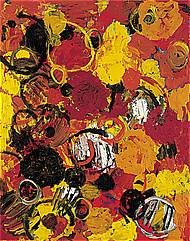Three exhibitions
dal 25/4/2007 al 22/9/2007
Segnalato da
25/4/2007
Three exhibitions
Stadel Museum, Frankfurt
"Constellations II" displays works from the museum collection dating to the second half of the 20th century. Wilhelm Lehmbruck's show is bult around the bust "Head of the Kneeling Woman of 1914" lent by Kirchner Museum in Davos. The Ernst Ludwig Kirchner exhibition focuses on the commission and development of "Life", analysing the 1928–1932 period of career of the artist.

Group show + Two solo shows
Constellations II
Curated by: Max Hollein, Dr. Sabine Schulze and Dr. Jutta Schütt
Constellations II offers a survey of the paintings, sculptures, installations, and works on paper from the second half of the twentieth century in the collection of the Städel Museum.
----------------------
Wilhelm Lehmbruck
A Bust Returns to the Städel Museum
The occasion of this exhibition is a generous loan from the Kirchner Museum in Davos: the bust Head of the Kneeling Woman of 1914 temporarily returns to the Städel Museum, having been removed from the museum in 1937, when Lehmbruck was still alive, as part of the National Socialist confiscation campaign. The exhibition built around this work, together with other works from the Städel and several other loans, directs the viewers attention to an aspect of Lehmbruck’s oeuvre that has thus far received little attention: the subtle and highly differentiated work with partial casts in various materials. The comparison of the full figures and partially casts in the work of the great German sculptor of the early twentieth century makes us aware of the influence that artistic decisions—a certain detail, a special material—can have on the perception of art.
----------------------
Ernst Ludwig Kirchner
Life, 1928–1932
Life, which measures just a little less than three by three meters of width, is the largest and most motivically elaborate tapestry by the German Expressionist Ernst Ludwig Kirchner. Against the background of simple rural life in the Swiss Alps, Kirchner formulated the motif of a worldview that contrasted rural and urban dwellers, allowing biographical elements into his work. This tapestry was hand-woven based on Kirchner’s designs by the weaver Lise Gujer; the idea and commission came from the collector and patron Carl Hagemann. The exhibition draws attention to this outstanding work by Kirchner and details the awarding of the commission, the development of the work, the process of producing it, and its provenance prior to reaching the Städel in 1966.
Städel Museum
Dürerstr. 2 - Frankfurt



